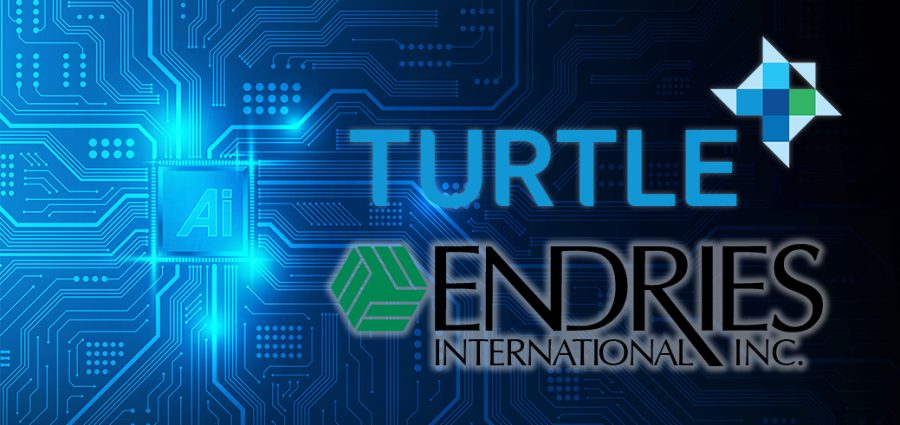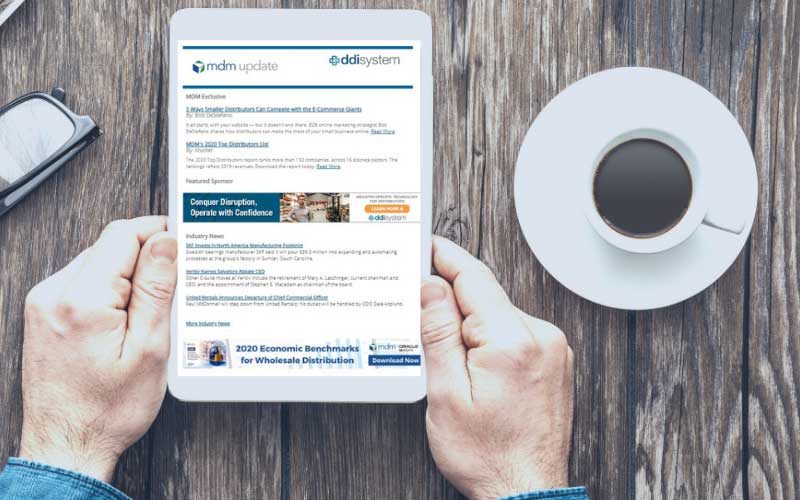If 2023 was the year of AI exploration in distribution, 2024 may have been the year of adoption. We detailed this past July how the industry’s AI adoption rate took a considerable leap in 2024, with our research indicating a 15 percentage-point increase in distributors that are using AI in at least one facet of their business compared to a year prior.
That kind of technology adoption rate increase is rare in distribution. Extrapolating that result further, the industry may already be north of the 60% participation mark if we ran that same survey today — we will in mid-2025.
Given the specific nuances of distribution and unique challenges that each of its product sectors entails, AI probably isn’t as much of the Wild West as some assume. As detailed in this Dec. 18 MDM Premium piece, distributors are finding success with tailored solutions that use their data or manufacturers’ data, rather than a public AI tool that they’re feeding info to (ChatGPT and the like).
At Infor’s Velocity Summit in Las Vegas this past fall, I sat down with David Magee and Todd Fischer — the respective Chief Information Officer at electrical distributor Turtle and fasteners distributor Endries International — for an in-the-weeds discussion on how these two companies approach AI and have scaled success with it.
I made sure to have Magee and Fischer address the biggest barrier to distributors’ AI adoption — the notion that their data is ready or clean enough for it. We also explored how Turtle and Endries prioritized what they wanted to achieve with AI; successes and failures along the way; and where they’re looking to drive the technology toward.
Check out our conversation below:
Mike Hockett, MDM: AI means a lot of different things to a lot of different people, but broadly, When your company is looking at AI and how it wants to use it, what are the strategic questions you and the leadership team are asking yourselves?

David Magee, Turtle: We always try to put it in one of two flavors: Is this an efficiency/ operational matter? Does it make us better? The second part is, can we monetize it? Those are the two litmus tests we go through from a strategic perspective because it means different things. From an organizational perspective, we want to maximize margin. So right now, I’d say 75 to 80% of our focus is on operational efficiencies. Being better, smarter, generating better margins and bottom line growth. But we have an incubator organization called Turtle X. It’s an organization that we fund from Turtle, and they’re focused on driving AI to be a revenue stream to monetize the ability to use AI for outcomes for customers — not just ourselves. So that’s where we start. The other key thing is we want to make sure we always have metrics around it. In a previous iteration of Turtle, about three years ago, [we] went heavy into AI and it didn’t get the outcomes we wanted. A lot of that was because we didn’t have the right metrics in terms of what success looks like. And we found ourselves in that conundrum of solutions looking for problems. So we try to make sure that we work with the business to articulate the need and figure out, ‘is this going to help the bottom line, or is this a monetization opportunity?’ That determines the working group and the ownership of how it gets taken from idea to inception.

Todd Fischer, Endries: We needed to get into AI, but the problem was, where do you start? (President and CEO Michael Knight) came to me saying that we need to be using it. At that point, everybody’s familiarity was only with ChatGPT, which doesn’t have any of your data, so it’s not going to be used much in the business. We started looking at different areas of the business and asking where we could apply it. We created a list. We actually sat down and brainstormed a list, and pricing was number one. We kind of fell on our face on that one because when we got into the room, it seemed like there were 20 different ways of pricing. None of them were wrong, but it became such a complex beast in our world that we decided to back off and start with part matching. But we created a list, and it included customer forecasting, lead time, improvement — all kinds of things where we believe AI could help us. That’s how we started. And now we’re starting to work through that list.
Hockett, MDM: When we talk with distributors about AI, we find that their interest far outweighs their current application of it. And when we ask why there’s hesitancy, they most commonly say their data isn’t ready — it’s not nearly organized and clean enough to start layering on AI. How did Endries and Turtle approach that?
Magee, Turtle: It becomes a work in progress. If you wait till your data is ready, then you’ll never be ready, because your data will never be ready. So there’s a point in time where you’ve got to launch, right? You’ve got to accept the data as it is and get the best value out of it. And what we see is this perpetuating value. We look at a subset of data; we’re making decisions about AI; which makes better decisions; which makes better data; which drives better decisions. So it becomes that iterative process that continues.
Fischer, Endries: We weren’t too worried about the data. The data is there. I did, though, identify areas where there were problems and maybe we needed to clean up. So the next thing, for example, we wanted to look at costing. We thought we had all our weights in the system and that they were accurate. We ran AI against it and found out that wasn’t so. So we put a project in place to fix the weights in the system. It’s a good thing, but we needed to fix the weights because the system was calculating costs wrong, so it was something that had to be done. But we didn’t go in worrying about if our data was good or bad. We went in with the mindset of what data do we need? And then let’s start refining it.
Magee, Turtle: There is a data quality improvement through the process. As you run it through the system, you find gaps, you find efficiencies, you fix it, you run it through, you get better outcomes. So you’re going to organically touch your data. To be crass a little bit, if you wait to have kids until you feel ready, you’ll never have kids. You’ll never feel ready. It’s the same thing, if you wait until your data is ready for AI, then you probably don’t need AI because you’ve done all the other necessary steps and you’ve missed a significant opportunity by waiting.
Hockett, MDM: Besides the whole AI component, what is the biggest digital challenge that your company is looking to solve or make headway on in 2025?
 Fischer, Endries: The thing that sticks out the most for us is non-value-added work. If our people are doing super basic task-y work, having them do it just because it needs to get done isn’t a good reason. We need to figure out how to get rid of it. So when we’re looking at things, it’s about how to free people’s time to do higher value tasks. Our customers are demanding, they have complex requests, and that’s OK because it makes them sticky with us if we can solve their problems. But we need to do it in a way that’s effective for us. And so that’s the big thing, getting rid of the waste in the business.
Fischer, Endries: The thing that sticks out the most for us is non-value-added work. If our people are doing super basic task-y work, having them do it just because it needs to get done isn’t a good reason. We need to figure out how to get rid of it. So when we’re looking at things, it’s about how to free people’s time to do higher value tasks. Our customers are demanding, they have complex requests, and that’s OK because it makes them sticky with us if we can solve their problems. But we need to do it in a way that’s effective for us. And so that’s the big thing, getting rid of the waste in the business.
Magee, Turtle: Digital transformation for us is about the customer experience. We don’t want it to be sticky because it’s complex or sticky because we know the process. We want it to be streamlined. Want it to be easy. So we’re leveraging it towards order fulfillment, pricing, backlog, history, shipping, parts availability — all of that. So we’re using AI to help predict that and figure out how we can improve everything about the customer experience and customer journey. Through that, we assume we’re going to develop the operational efficiencies to drive that experience. The experience is the direct and indirect experience of the customer, and the indirect will be organic, but the direct will be purposeful.
Fischer, Endries: It’s the same for us. We’re providing that customer experience today but at a very high cost. I think right now, our customers say “We had a great experience with you.” That’s why they’re sticky. How the heck do you do it without too high of cost?
 Magee, Turtle: That’s what we’re trying to do. If you look at the number of people and technologies that have to touch a customer to deliver that whole journey. AI has to be able to fix and improve that, and we’re seeing it. We’re just careful and cautious in bite-sized chunks. We’re not trying to reimagine the entire life cycle overnight. It’s “OK, let’s handle this part of it, and then that part of it” and finding wins. If I get a win today, then I get enough leverage to get to try for my second win tomorrow.
Magee, Turtle: That’s what we’re trying to do. If you look at the number of people and technologies that have to touch a customer to deliver that whole journey. AI has to be able to fix and improve that, and we’re seeing it. We’re just careful and cautious in bite-sized chunks. We’re not trying to reimagine the entire life cycle overnight. It’s “OK, let’s handle this part of it, and then that part of it” and finding wins. If I get a win today, then I get enough leverage to get to try for my second win tomorrow.
Fischer, Endries: The biggest thing probably most distributors assume is that if you need data science, you need to bring in a data scientist. I mean, if you’re thinking that way, you’re probably thinking about it wrong, because you probably don’t want to bring a data scientist on staff. I mean, first of all, if they leave, you got a problem anyway, you want to have somebody behind it. And the cost to get into it with Infor is probably the cost of what a data scientist would be.
Magee, Turtle: We had a data scientist, so this is our second foray. Three years ago, our prior IT leadership went heavy in AI. We invested in tools, technology and people, but just couldn’t get there. And then when I came onboard, we changed course and relied on partnerships, and our plan was in commercialized AI solutions that could be configured and customized to our needs. Folks like Infor have a framework and understand our operations; they understand our ERP; they understand our data. I want them to take the burden of the heavy lift of the data science of the process automation and continue to be a value-add contributor. I don’t necessarily need them to reimagine the wheel. I just need to go to them and tell them how big and how many spokes.
Fischer, Endries: That’s well said. I think a lot of distributors assume you need to do it alone to save on costs. Don’t. You’ll get stuck if you try to do it all yourself and build it in-house. You’re dead before you get started.



